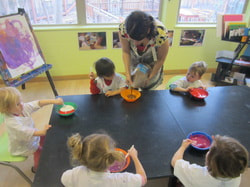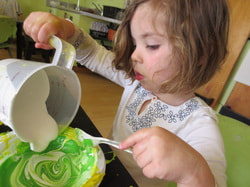How can we expand the children’s schema about color and paint through the process of researching the many impressions of one color?
The children have spent several weeks researching the possibilities of red, yellow, and purple through a process of gathering materials representing shades of each color, creating new shades of paint, drawing with a range of shades, and collage. We encountered an unexpected conundrum when exploring shades of red - lighter shades of red expressed the color pink, darker shades of red expressed the color purple, and medium shades of red expressed the color orange. We wondered, do shades of red exist and if so, what do they look like? This question was prevalent in our experience creating shades of red with paint as the slightest addition of a new color negated the presence of red. We wondered what other colors exist as a sole shade, that transform to a completely different color when combined with other colors? White? Black?
An additional avenue we would like to experiment with for exploring the many impressions of a color involves families taking home jars of paint and matching the color in the jar to something they encounter in the environment.
An additional avenue we would like to experiment with for exploring the many impressions of a color involves families taking home jars of paint and matching the color in the jar to something they encounter in the environment.
How can offer experiences for creating new colors so that the children are gaining more knowledge about the process and science of color transformation rather than facilitating the experience as a means to an end - to create new jars of paint?
Two insights we have pulled from our observations include 1) finding ways to create more autonomy for the children in these experiences and 2) slowing down. In regard to the former, we noticed that the teacher was doing most of the work, mostly because the children could not manage the gallon jugs and because the teachers wanted to get through the other stuff quickly, such as transferring the new colors to the jars and rinsing out the bowls for a new color, because they wanted the children to focus on the mixing aspect of the experience. In regard to the second point, we hypothesized that our inclination for speed in getting through the many steps (dispensing paints, transferring paints, and washing bowls) was actually taking away from the children's opportunity to really, truly slow down and experience the process of color transformation. Instead, they became focused on the end goal - putting the paint into the jar.



